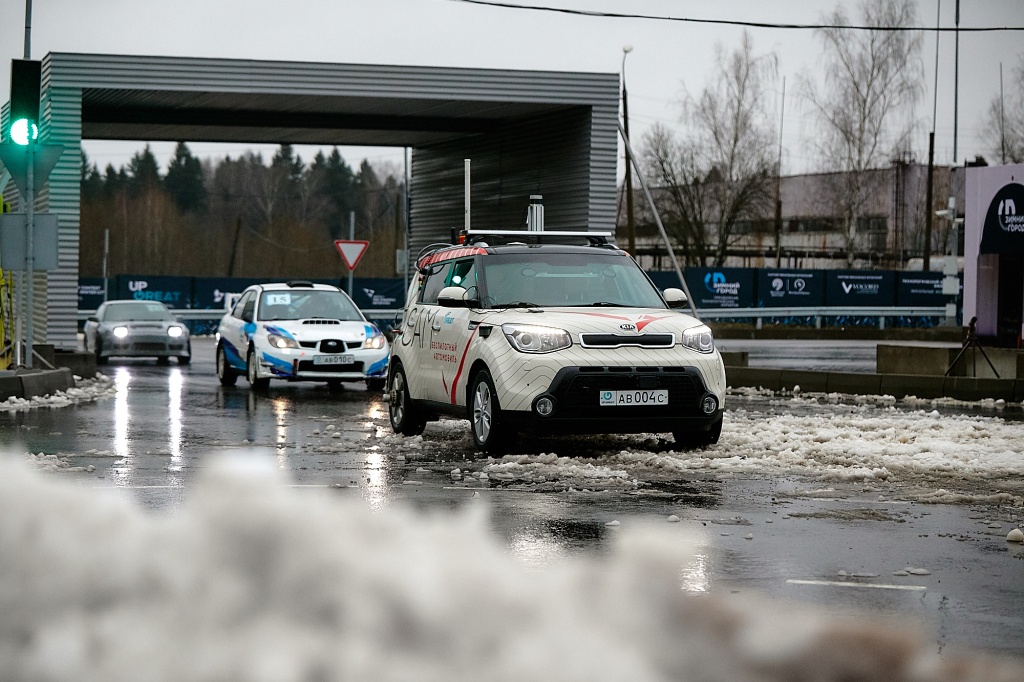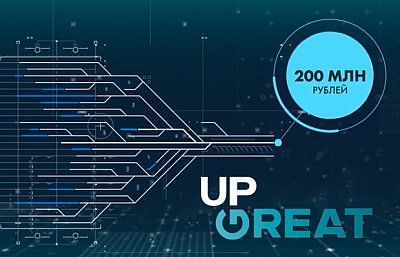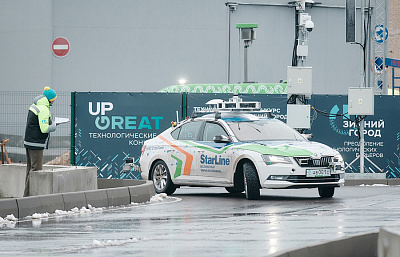Never give up or how unmanned vehicles were fighting Russian winter

Report from the «Winter City» technology contest
On December 10, 2019 the final event of the technology contest Up Great «Winter City» took place in Dmitrov, Moscow region. Almost real Russian winter, twilight, road markings covered with snow, hardly visible road signs, uncontrolled intersections, tunnels and railway crossings. Those were the conditions in which five brand new Unmanned Vehicles (UVs) from Moscow (MADI and BaseTracK), St.Petersburg (StarLine), Nizhny Novgorod (NNSTU) and Taganrog (Avto-RTK) were to drive 50 km in less than 3 hours in order to overcome technological barrier, get 175 mln rubles and more importantly respect of professional community. Abrupt mechanical failures, unexpected returns to the track, dramatic jury decisions, the second chance, dead batteries and appeals — read about most dramatic moments of the “Winter City” contest in the report by Marina Kiseleva and Yuri Sushinov.

Journalists and photographers were walking along the specially designed NAMI auto testbed, taking pictures of the cars at the start line and road signs covered with paint (to create winter environment in the lack of snow). Pedestrian dummies Nadezhda (in Russian — Hope) and Lyubov (in Russian — Love) were waiting at the crossing. During the race, they would repeatedly cross the road along the specially created rails.
Meanwhile, in the Situation Center guests were concentrated on ethical questions: “Are UVs able to react to the road police gestures?” “What should the road policeman do when he doesn’t find a driver in the car?” “Who will be held responsible if the vehicle drives at Lyubov, or which is worse hits Nadezhda?”
Experts were sharing their expectations: some asserted that two or three teams would definitely overcome technological barrier, others claimed that whatever the outcome all the finalists were already the winners and in demand on the market.

“The main aim of the contest lies exactly in overcoming technological barrier. There are no self-driving cars by now reliably operating in a winter road”, said Alexander Povalko, the Head of the Russian Venture Company speaking to the press before the race.
“All contest participants, especially those who reached the finals, will either create their own projects to develop… or will be purchased by bigger companies, said special representative of the president on digital and technological development Dmitry Peskov.
“Nowadays the company cannot be called ‘technological’ if it does not possess competences in unmanned vehicles. That is why all the teams here are bound to the brightest future whether they win the competition or not. 200 engineers, participating in the contest, are strategic resource of our country, its main reserve. And our goal is to enable them to realize their potential inside the country”, Peskov told the journalists.
“There will be no winners”, said Skolkovo senior vice-president Kirill Kaem on behalf of the organizers. “Lots of them (“Winter City” participants — ntinews.ru) have already found huge industrial partners to integrate and implement their solutions. And we will definitely gain from it as a country for all the competencies and people engaged in UV development, will stay here”, stressed Kaem
Prologue. There were five of them at the start
At 14:30 the race started. It was a silent start, not a spectacular one. Some visitors were still finishing their dinner discussing teams’ perspectives, while the vehicles were already on their way, moving quite fast.

Besides five contestants, there were five imitators on the road with professional drivers inside to model the real traffic. Yet one could easily recognize UVs by their special body kits with numerous sensors and by the way, they were driving. For instance, they could suddenly stop to analyze the situation and learn from it and then move forward again.
And though federal traffic regulations forbid that, Technology Contest rules allow such stops if the vehicle does not get in the way of the other participants. There were also more violations of the traffic rules on behalf of the contestants — they could run a red light, fail to give way to the traffic on the right, etc. All the violations added minutes to the total racing time. And though it seemed that nothing was actually happening — the cars were just driving along their route — there was tension growing inside the teams: electronics could fail, batteries could discharge, the weather could change all plans. It was raining, the road was wet.

Artificial snow on the track was melting into slush. BaseTracK had had a problem the day before the race — power steering stopped working. While for a regular car it is not a big problem — it is just more difficult for the driver to steer the wheel — in a UV it controls the movement, it cannot drive without it. “I found this part on Avito, took it from the owner at night and at 7 o’clock we installed it, so the car started the race without any preliminary testing», said the BaseTracK team leader Andrey Vavilin.
Half an hour after the start MADI car suffered a technical failure. It suddenly stopped in the middle of the difficult road section with a bend, side road and turn to the right. “Some road situations which are nothing for a human, are almost unmanageable for a UV at the present stage of technology development”, commented the incident operational Director of Technology Contests Up Great Konstantin Kaysin form RVC.
According to the experts, the car stopped to analyze situation, to learn. As the vehicle did not prevent other contesters from driving, it did not violate the Contest traffic rules.

What happened next? Other UVs started to stop one by one behind MADI vehicle thus creating a traffic jam. Avto-RTK team continued the race driving around MADI vehicle, but managed to do it only twice. Returning to its lane after overtaking one contestant and intending to pass by another one Avto-RTK suddenly stopped, blocking the only free lane left, which made it impossible to continue the contest. As a result, Avto-RTK team was disqualified. “After some discussion the jury decided to follow the rules and threw out the team, which did nothing wrong, except trying to overtake the competitors. Though disqualification did not change anything — the last UV soon joined the traffic jam”, one of the spectators commented on the situation.
Technical break was announced. MADI vehicle remained at its place, while other contesters were too afraid to make further attempts to pass it by. As a result, UVs blocked each other and the Jury decided that it was impossible to continue the race. The first ever traffic jam of unmanned vehicles — done! Now the Russian Technology Contest “Winter City” will surely go down in history!
Endless second chance
“We restart the contest, all the teams have another chance to show themselves, because this contest is an unprecedented event!” proclaimed Michail Antonov, Deputy CEO and Director for Innovation Infrastructure Development at RVC two and a half hours later. But only two teams were actually ready to take a second chance — StarLine and MADI. Remaining three UVs were technically unable to take part in the contest. “NNSTU Electric Gazelles and BaseTracK driverless car could not participate for their batteries were low. Avto — RTK also declined to participate», organizers of the contest said.

According to BaseTrack leader Andrey Vavilin, his team was ready to take part in the contest for the second time, but only if they had been allowed to recharge the battery to the appropriate level. “After 5 km and almost 3 hours in a traffic jam our vehicle did not have enough battery to cover the whole distance”, said Vavilin. “When we got the car only 68% of the battery was left, so we had to recharge it for at least 3 hours”. Later on it was discussed that one of the teams rejected the second attempt for pragmatic reasons — not to risk the car, which cost 18 mln rubles.
So three teams appealed against the second race. “Having spent almost 3 hours trying to find a legal solution of the stalemate, organizers decided to go for a complete restart, which is of course not allowed by the contest rules”, Andrey Vavilin wrote on his FB page. “We had to appeal against this decision and reject a new race. Two other teams did the same”.
It was already dark when the contest continued, which made the road conditions even worse. But 15 minutes later the Jury had to announce another technical break. MADI vehicle stopped again, but now at the point where it could not be overtaken without breaking the traffic rules. This time MADI vehicle was disqualified.
The last Russian UV or how to push your limits and drive 50 km
After MADI team disqualification there was only one participant left — StarLine. Now it was competing against itself. St. Petersburg team saw a real chance to get 175 mln rubles. Half of the way was made in 1 hour 25 minutes.

«We claimed that we would make an unmanned vehicle and test it in real-life conditions. That’s why we will fight until the end, use all the chances, make the best of us”, said the team representative to the audience of the Situation Center.
So unlike the previous round, the finals of the contest “Winter City” turned out to be really dramatic. Technical failures, world first traffic jam with unmanned vehicles, disqualifications, restart and appeals, again disqualification. And as a result only one team was left which actually was fighting not for money but against its own technical limitations. And the whole world was watching. Darkness, mud, slush, resentment and slight hope — what if it still gets to the finish line?

But at the 38th kilometer StarLine crashed into the wall and stopped. Next 20 minutes nothing was happening, the Jury stopped the timer, they had to decide what to do with the car and the contest — finish everything, announce new technical break, something else. Only Lyubov and Nadezhda were still walking along pedestrian crossings. The spectators were joking that pedestrian dummies turned out to be the most reliable means of transport. It seemed that it was the end. But suddenly the car started to move again.

“The vehicle had an accident at the bend of a country road. Radio interference caused the jump in localization, which was compensated by the operational system. But the error remained, the vehicle swerved from the road and failed to return to the route”, said StarLine Project Director Boris Ivanov after the end of the contest.
At the end of the day, it took StarLine 2 hours and 47 minutes to cover the distance of 50 km. But this result was not counted as it was given extra 73 minutes for violations of traffic rules (in most cases running a red light). So as a result — not a single team managed to break technological barrier. But is it actually so important?
Epilogue. Why this failure is actually a success
“Formally no — too many penalty points. But de facto — it is a victory! Russia has a new technology champion — StarLine”, Dmitry Peskov wrote on his FB page.
Now it is time for reflection. What caused technical failures? Why did MADI vehicle stop? Why Avto-RTK did not manage to avoid an obstacle? Why did the traffic jam appear and the UVs did not dare move? Why StarLine vehicle stopped for 20 minutes and then started again? The Jury still have to deal with appeals and their own decisions. But in spite of all the drama about this contest we can definitely say that in Russia there are teams that are ready to create unmanned vehicles, that can compete in the world market.
Situations that took place in “Winter City” finals are not extraordinary. It is not a failure of Russian technologies or so. Those things happen all over the world when it comes to real-life tests, but not demonstration of success stories on company websites or social media.
“There is now a huge gap between the real level of technology development and its marketing. Any unmanned vehicle producer can demonstrate how great its car is in the official video recorded from the first-fifth–tenth time. But everyone has a number of videos behind the scenes when the vehicle just doen’t work’ — said Kaysin. Companies all over the world that produce unmanned vehicles are constantly facing unexpected soft bugs, so the world is not going to switch to unmanned cars in the nearest future.
You can get into the car brains and understand why this or that situation caused difficulties. But even when you cope with existing problems you can never be sure that next time your vehicle is not going to hit a pedestrian due to another soft bug. And though addressing the problems on a case-by-case basis might seem less efficient than facing global technological challenges, no one seems to have a global solution yet. It definitely takes time. So Russian StarLine with its damaged and dirty vehicle, which has finally managed to reach the finish line, is definitely a winner, at least morally.
P.S. Comments from StarLine
StarLine officials did not elaborate much about the contest and its outcome. Here is what the only team that came to the finish line said:

“The competition was really tough. Our vehicle had to drive under harsh conditions: signal interference, low luminance in some parts of the testbed, intense traffic and sometimes unpredictable behavior of the imitators. Yet we could rely on our vehicle.
The traffic jam at the crossroads was ok. One of the main tasks of unmanned transport is to improve safety. But safety issues are in a way confronting traffic rules at the crossroads. All the vehicles were programmed to drive safely, but one car stopped, which caused a traffic jam.
All the UVs proved that in the future such situations can be avoided at the stage of road markings design by allowing or forbidding changing lines at the difficult road sections and defining exact directions for each lane.
To drive 50 km in autonomous mode was our personal challenge and a great opportunity to test our self-driving technologies. During the accident the car was not seriously damaged: only two sensors stopped working: lidar and radar. So the decision was made to switch them off and continue the race.
Technical equipment of StarLine vehicle is specially designed in a way that different sensors could complement each other and in case of emergency could substitute for each other.
We are satisfied with the result. In fact the vehicle made a distance of 58 km, as in every round it drove additional 800 meters because of the route extension. The team decided to drive around the tunnel because of the possible tailbacks in this section. The distance increased, but we gained in time. The car showed stable operation — it was a great chance for us to test self-driving technologies being developed.
By now self-driving equipment and the car itself cost NPO StarLine about 6 mln rubles. In 2020 the company plans to certify its autonomous vehicle and start testing it on the public highways of St. Petersburg and Leningradsky region”.
Technology contests Up Great for Russian innovative companies are initiated by RVC, Skolkovo Foundation and Agency of Strategic Initiatives within the framework of National Technology Initiative. The Contest operator is Russian Venture Company.
Participants of the contests are invited to find solutions to the world’s technological challenges in a variety of areas. Results of the contests must be visualized in the form of a working prototype and should be recognized by independent experts and the public.The winning team is awarded a serious money prize. Contest mechanics has been developed in accordance with best practices of the world technology competitions: XPrize, Darpa Grand Challenge, etc.
Up Great contest “Winter City” is aimed at development of the technologies of safe automatic driving of unmanned ground vehicle under climatic and road conditions of Russia. Contest participants are to develop a driverless car adapted for movement during winter season and at different times of the day, in compliance with the traffic regulations of the Russian Federation.




























